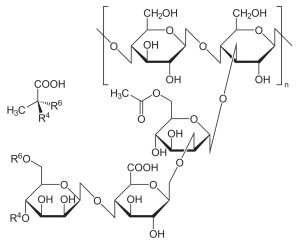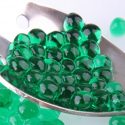What is Xanthan Gum (E415) in food: Uses and Substitutes

Made of | Production | Property | Uses | Substitutes | Safety | FAQs
Xanthan gum, a high-molecular-weight extracellular polysaccharide widely used as a thickener, emulsifier and stabilizer in food with the European food additive number E415. It is different from other polysaccharide gums (same with gellan gum) as made from bacterial fermentation while others are extracted from or parts of a plant.
What is Xanthan Gum made of?
Mainly composed of a repeat pentasaccharide unit consisting of D-glucose, D-glucuronic acid, D-mannose, pyruvic acid and acetic acid. The latter three substances exist in the form of 4,6-pyruvylated mannose and 6-acetyl mannose.

Structure of repeating unit from Wikipedia
The ratio of above three monosaccharides, glucose: mannose: glucuronic acid is 2:2:1. The substitution degree of pyruvic acid and acetic acid depends on the media culture compositions and fermentation conditions.
How is Xanthan Gum made?
Commercial Xanthan gum is produced by fermentation of a carbohydrate source (mainly from corn starch) with strains of Xanthomonas campestris (a naturally occurring bacterium can be found on the leaf surfaces of green vegetables), then purified with ethanol or isopropanol. The final product is manufactured to a salt (sodium, potassium or calcium).
Specification
| Other names |
|
| CAS number | 11138-66-2 |
| Chemical formula | NA, C35H49O29 (monomer) |
| Molecular weight | Approximately 1,000,000 |
Properties
Appearance
Cream-coloured powder with a neutral flavor taste, commonly supplied 80mesh and 200 mesh in the market.
Solubility
- Soluble in both hot and cold water with pH 5.5–8.5 for its 1% solution (25°C)
- Insoluble in ethanol
Viscosity
High viscosity with low level
A high viscosity can be achieved with a low concentration and the common usage in food for thickening is 0.5% or less. Generally, the viscosity of its 1% solution is between 1200-1700 cps that is around 100 times stronger than that of gelatin.
Stability
The solution viscosity is stable and almost not be influenced by the changes of pH (pH 3 – 11), salts (10% KCl, 10% NaCl2, and 5% Na2CO3) and temperature up to 90°C, while other hydrocolloids (pectin, sodium alginate) will break down under such conditions.
Synergy
Synergistic interaction with other plant galactomannans in increasing viscosity, such as with guar gum (higher viscosity), locust bean gum (can form a gel), carrageenan and konjac glucomannan. It also has a synergistic effect with starches (prevent starch gelatinization) or modified food starch.
Shear-thinning
Viscosity is high in low shear rate and become low at a high shear rate, but returns to its original viscosity once the shear forces are removed. The pseudoplastic property plays an important role in stabilizing, thickening, suspension and emulsion.
Thickener
Xanthan gum is primarily used as a thickener to increase the viscosity of a liquid without changing other properties of food, such as in fruit drinks, fruit juice concentrates, sauce, and salad dressing.
Emulsifier
It also acts as an emulsifier to help prevent oil and water separation, improve protein stability, prevent fat floating, and prevent protein precipitation by stabilizing the O/W emulsion due to its lipophilic and hydrophilic groups. Such applications are in protein and milk beverages.
Not a gelling agent
It is not used as a gelling agent due to its weak gel strength or almost non-gel strength, but it can form a firm rubbery gel with locust bean gum, with a concentration of 0.5%, respectively.
What’re the Uses of Xanthan Gum?
With the properties of resistance to acid, alkali, salt, heat and enzymes; plus the multi-function of suspension, emulsification, stability, and thickening, xanthan gum is the most used gum in the food market and also widely used to thicken drilling mud, textiles and cosmetics.
Thickening with xanthan gum is commonly found in the following food products:
- Baked goods
- Dressings, frozen desserts
- Confections
- Cake and dessert mixes
- Dairy products
- Ice cream
- Pudding and gelatin mixes
- Jams and jellies
- Sauces & Seasonings
- salad dressings
- Meat & Egg Products
- Cookies
- Puddings
- Soup
- Instant products
Baked food
Xanthan gum can be used in bakery (e.g. bread, cookies, biscuits, muffins, cakes) mainly for the following purposes:
- Add loaf volume
- Makes a higher crumb strength
- Increases water retention
- Impart a smooth taste and texture
And therefore it delays starch aging and extends the shelf life of baked goods and refrigerated dough.
It can also be used as a substitute for eggs to reduce the usage of egg white but without affecting the soft taste and appearance. Adding it to the bread spread can prevent the spread of dehydration caused by the water absorption from bread.
Xanthan gum can also be used in gluten free baking to replace the function of gluten to bind flour together which does good to people who have celiac disease.
Beverage
- Improve the mouthfeel of the beverage, e.g. in fruit and chocolate beverages, the blend with carboxymethyl cellulose sodium (CMC) is commonly used.
- Stabilize suspension for fruit pulp and other insoluble ingredients, e.g. in corn beverages used together with konjac gum.
- Improve the taste in plant protein beverages, reduce the amount of emulsifier used and make the product stable, such as the combination with guar gum in peanut protein beverages.
Salad dressings
During the heat-stable salad dressings production, it adds smooth and distributes other ingredients evenly to the salad.
Ice cream
Generally a stabilizer for ice cream and functions as follows:
- Prevent water lose during freeze-thaw cycles
- Improve water retention
- Anti-melting
- Increase expansion rate
- Impart a smooth texture and creamy mouthfeel
- Prevent the formation of ice crystals
Sauces
With excellent salt, acid and alkali resistance, and the ability to thicken both hot and cold sauces, xanthan gum can be used as a thickener to replace starch and overcome the shortcomings of starch precipitation, make sauces fine and uniform, improve the coloring, and extend the shelf life.
Meat
Xanthan gum can also be used as a water-binding agent and texture modifier in sausage and brine-injected ham to increase water holding capacity, impart a smooth and elastic tenderization.
Other food uses
- Soups & gravies: to thicken both cold or hot soups and gravies.
- Pudding & yogurt: stabilize milk and provide a better mouthfeel.
- Protein shake: thicken protein powder.
What are Xanthan Gum Substitutes?
The common alternatives for xanthan gum in some food uses are the following 9 ingredients: cornstarch, psyllium husk, sodium carboxymethyl cellulose (sodium CMC), agar agar, gum arabic, Locust bean gum, konjac gum, gelatin and carrageenan.
Among the above replacements, only psyllium husk, guar gum and locust bean gum are defined as dietary fiber which has the benefits of (1):
- Lowering blood glucose/blood pressure/cholesterol levels
- Improving laxation
- Reducing energy intake
The difference between xanthan gum and the substitutes are mainly in five aspects:
- Source
- Viscosity
- Gelling ability
- Stability: this property makes xanthan gum standout
- Dietary fiber or not
Let’s see the nine substitutes:
Cornstarch
Native corn starch is separated from corn and used widely as a thickening agent in fresh food or food for short-time storage due to the limited application caused by, e.g. the insolubility in water, unresistant to acid, heat or shear. Therefore, native corn starch is sometimes made to modified corn starch for specialized uses.
Following are some advantages of xanthan gum than corn starch:
- Usage: Less amount is needed to obtain a desired viscosity. Xanthan gum does not need to be heated to thicken while corn starch does.
- Stability: maintain a more stable viscosity.
- Clarity: provide a transparent solution while corn starch makes the solution cloudy.
Psyllium husk
Psyllium husk, the seed coat from the psyllium seed, which can be used as a source of fiber and also can replace xanthan gum as a thickener or binding agent in gluten-free baking.
Sodium carboxymethyl cellulose
A cellulose derivative or the sodium salt of CMC, to improve the solubility of CMC in water, made from the natural cellulose after alkalinization and etherification. It is another popular thickener (not a gelling agent) in food with the properties of thickening, suspension, emulsification and stabilization. Learn more about Sodium CMC
Agar agar
A polysaccharide extracted from the red algae of the class Rhodophyceae, insoluble in cold water, commonly used as a gelling agent in jelly and can replace gelatin. Learn more about Agar Agar
Gum arabic
A water-soluble polysaccharide comes from stems and branches of acacia senegal and acacia seyal, mainly used in chocolates, candies and chewing gum. Learn more about Gum arabic
Locust bean gum
It is the endosperm of the seed of the carob (locust) tree, this polysaccharide is commonly used as a thickener (can also be acted as a gelling agent but with a high concentration) in ice cream. Learn more about LBG
Konjac gum and Konjac glucomannan
Water-soluble polysaccharides with the strongest viscosity, made from the root of the konjac plant, used as a thickening and gelling agent commonly in meat products, pastas and noodles. Learn more about Konjac
Gelatin
Commonly made by cooking collagen from the skin and bones of fish, beef and pig and mainly used to produce a gel in yogurt, pudding and ice cream. Not suitable for vegetarians as originated from animals. Learn more about Gelatin
Carrageenan
Extracted from red algae, with both thickening and gelling properties. This ingredient can be divided into three types: Kappa, Iota, and Lambda according to the source of red algaes and classified into two grades (semi-refined and refined) based on the different manufacturing processes. It is mostly used in meat. Learn more about Carrageenan
Is Xanthan Gum Safe to Eat?
Yes, it almost has no side effects and the safety has been approved by the U.S. Food and Drug Administration (FDA) and European Food Safety Authority (EFSA), as well as the Joint FAO/WHO Expert Committee on Food Additives (JECFA).
FDA
Xanthan Gum derived from Xanthomonas campestris may be safely used as a thickener, stabilizer, emulsifier, suspending agent, bodying agent, or foam enhancer in food. (2)
EFSA
Xanthan gum (E415) is listed in Commission Regulation (EU) No 231/2012 as an authorised food additive and categorized in “ additives other than colours and sweeteners” (3).
Safety re-evaluation in 2017
After the studies of carcinogenicity, genotoxicity and other researches, EFSA concluded there is no safety concern and no need for a numerical ADI for xanthan gum (E415) when used as a food additive. However, there is a maximum use level for infants. (4)
Approved uses
Its application is listed in “Group I” with the maximum level “quantum satis”. The following are some of its separate uses (5):
- Jam, jellies and marmalades
- Meat preparations
- Table-top sweeteners in powder/liquid form
- Processed cereal-based foods and baby foods gluten-free cereal-based foods
UK Food Standards Agency
Categorized in “Emulsifiers, stabilisers, thickeners and gelling agents” (6)
Food Standards Australia New Zealand
It is an approved ingredient in Australia and New Zealand with the code number 415. (7)
JECFA
Function Class: food additives, emulsifier, thickener, foaming agent, stabilizer. (8)
Acceptable daily intake: ADI “not specific” set in 1986. The maximum use level of 1000 mg/L was established for infant formula in 2016. (9)
Frequently asked questions
Why is xanthan gum easy to agglomerate?
Xanthan gum is a hydrocolloid, which has a good solubility in water without the need to heat and with a faster hydration rate.
However, if the liquid is not sufficiently stirred during the dispersion process, the out layer of the particles of xanthan gum absorbs water and swells fast, while leaves the inner parts still dry and prevent water enter into, and thus agglomerates are formed.
Which delays the dispersibility and dissolution rate of xanthan gum and prolongs the dissolution time, resulting in that the viscosity cannot be completely achieved in a short time.
How to dissolve or use xanthan gum?
If not dispersed properly, it is easy to agglomerate. To avoid lumps, here are some suggestions:
- Mix it with other dry ingredients first before use
- Slowly added with a low hydration rate in the premixing process
- Disperse it slowly into a vortex of liquid using a high shear mixer
- Spray polysorbate 80 to xanthan gum and mixed with maltodextrin
Does xanthan gum have carbs?
It is soluble fiber which is a non-digestible carbohydrate, but it cannot be listed as a dietary fiber in the label per the FDA guidelines. (10)
Is Xanthan gum keto friendly?
Yes, it is keto friendly as with low carbs.
Is it Natural?
There is no clear distinction between natural and unnatural ingredients. Xanthan gum is a microbial-derived ingredient manufactured by fermentation.
It is not nature if natural means the apple in the tree. While it is if the alcohol fermented from bacteria is called natural.
Can xanthan gum be used in halal, kosher and vegetarian foods?
Yes, it is halal, kosher and vegetarian if processed using isopropyl alcohol. Otherwise, it is a questioned ingredient for kosher and halal as ethanol is a concern.
No matter ethanol or isopropyl alcohol is used, xanthan gum is vegan as the raw materials and the manufacturing process without the products come from animals.
Is it Non GMO?
Yes, most of xanthan gum in the market is without GMO as produced from Non-GMO corn (corn is the main source).
Is it Gluten free?
Yes, it is gluten free and widely used in gluten free food as it does not contain wheat, rye, barley, or crossbreeds of these grains. Also, it can replace gluten to improve texture in baked goods.
What’re the health benefits?
Different with dietary fiber, xanthan gum does not
- Control your appetite to control their energy intake, this statement was established by the EFSA in 2010. (11)
- Changes in bowel function, e.g. more frequent bowel movements. (12)
Conclusion
Now you may have a knowledge of the thickener – Xanthan gum (E415), from the following aspects:
- Manufacturing processes.
- Property: solubility, viscosity, stability.
- Uses: beverage, salad dressings, ice cream, sauces, meat and so on.
- Nine substitutes and their differences with xanthan gum.
- Safety
- FAQs: how to use, is it keto, halal, kosher, vegan, GMO free and health benefits.
What kinds of food labels have you found this ingredient in? Or if you have any questions or remarks about this additive, feel free to let me know in the comments.



Can i add xanthan gum to freshly squeezed pineapple juice. And again can I add it to milk powder to prevent the water from separating from the powder
Hi Samuel,
Yes, you can try